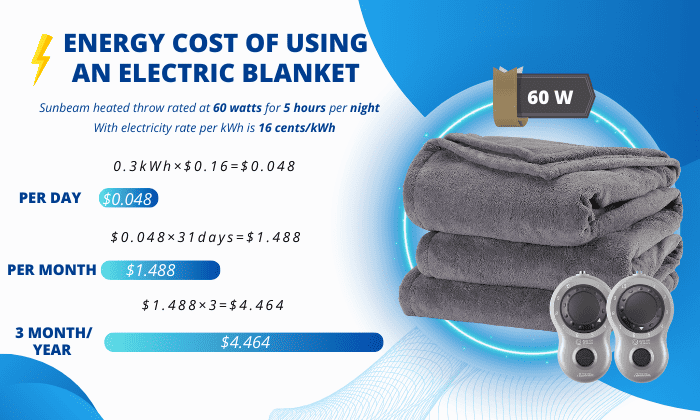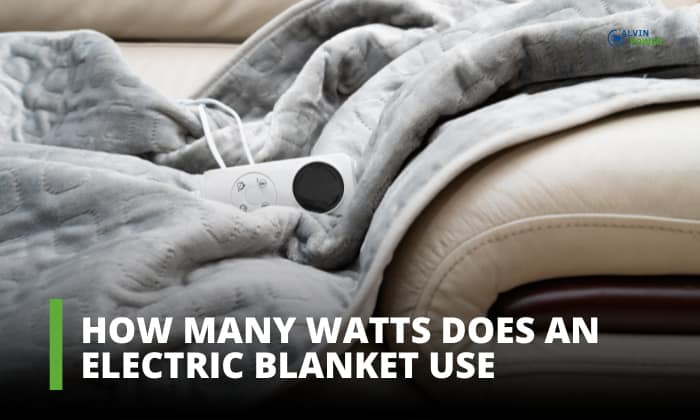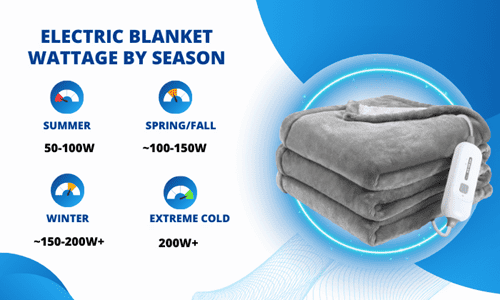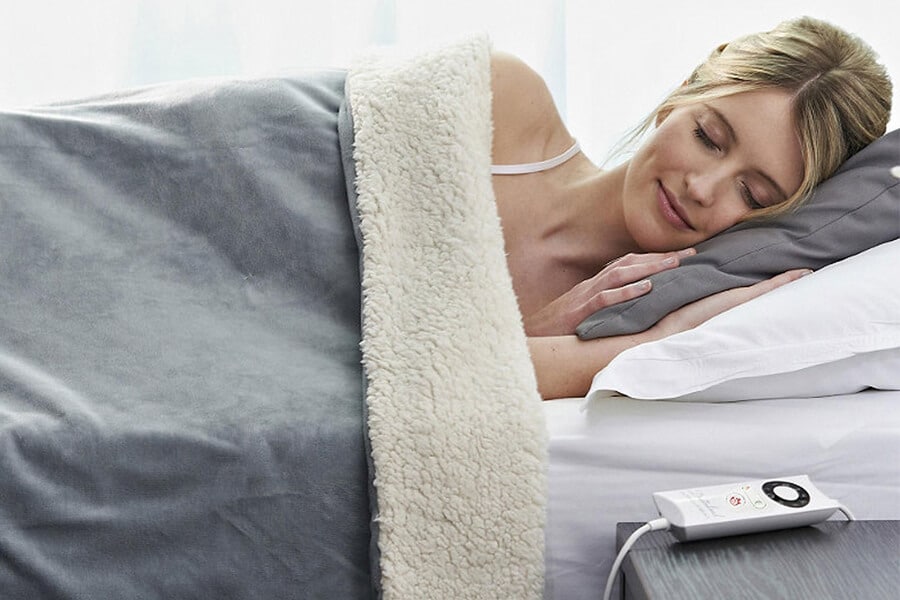How Many Watts Does A Heated Blanket Use

Frequently Asked Questions: Heated Blanket Wattage
Heated blankets are a cozy and energy-efficient alternative to cranking up the central heating, particularly during colder months. However, understanding their power consumption is essential for managing your energy bills and making informed purchasing decisions. This FAQ aims to answer the most common questions about the wattage used by heated blankets.
Q1: How many watts does a typical heated blanket use?
A typical heated blanket uses between 60 and 200 watts. The exact wattage depends on several factors, including:
- Size: Larger blankets generally consume more power than smaller ones.
- Material: The type of fabric and its insulation properties can influence wattage.
- Heat Settings: Higher heat settings draw more power than lower settings.
- Brand and Model: Different manufacturers and models have varying energy efficiency.
To get a precise figure for your blanket, check the manufacturer's label or the product manual. This information is usually located on a tag attached to the blanket or printed directly on the controller.
Q2: How can I find the exact wattage of my heated blanket?
Finding the exact wattage of your heated blanket is crucial for accurate energy consumption calculations. Here's how:
- Check the Product Label: This is the most reliable source. Look for a tag or label attached to the blanket or the power cord near the controller. The label should list the wattage (W) or power (P). It may also list the voltage (V) and amperage (A); you can calculate the wattage by multiplying these two values (W = V x A).
- Consult the User Manual: If you still have the user manual that came with your heated blanket, it will likely contain the wattage information in the specifications section.
- Search Online: If you know the brand and model number of your blanket, you can often find the product specifications online on the manufacturer's website or at online retailers.
- Use a Watt Meter: A watt meter is a device that plugs into an electrical outlet and measures the power consumption of any appliance plugged into it. Simply plug your heated blanket into the watt meter and turn it on to your desired setting to see the real-time wattage usage. These meters are readily available online and at hardware stores.
Note: Some heated blankets have different wattage ratings depending on the heat setting. The product label may list the maximum wattage, which is the power consumption at the highest heat setting.
Q3: How much does it cost to run a heated blanket?
The cost of running a heated blanket depends on its wattage, how often you use it, and the cost of electricity in your area. Here's a breakdown of how to calculate the cost:
- Determine the Blanket's Wattage: As mentioned earlier, find this information on the product label or user manual. Let's assume a blanket uses 100 watts.
- Convert Watts to Kilowatts: Divide the wattage by 1000 to convert it to kilowatts (kW). In this case, 100 watts / 1000 = 0.1 kW.
- Determine Usage Hours: Estimate how many hours you use the blanket per day and per month. For example, let's say you use it for 8 hours a day.
- Calculate Daily Kilowatt-Hour (kWh) Consumption: Multiply the kilowatt usage by the number of hours used per day. 0.1 kW * 8 hours = 0.8 kWh per day.
- Determine the Cost of Electricity: Check your electricity bill to find the cost per kilowatt-hour (kWh). This cost varies depending on your location and energy provider. Let's assume the cost is $0.15 per kWh.
- Calculate Daily Cost: Multiply the daily kWh consumption by the cost per kWh. 0.8 kWh * $0.15/kWh = $0.12 per day.
- Calculate Monthly Cost: Multiply the daily cost by the number of days in the month. $0.12/day * 30 days = $3.60 per month.
Therefore, using a 100-watt heated blanket for 8 hours a day at a rate of $0.15 per kWh would cost approximately $3.60 per month. Remember to substitute your blanket's actual wattage, usage hours, and electricity cost for a more accurate calculation. Using a lower heat setting will further reduce the cost.
Q4: Are heated blankets energy-efficient? Compared to what?
Heated blankets can be considered relatively energy-efficient, especially when compared to heating an entire room or home with a central heating system. Here's why:
- Targeted Heating: Heated blankets provide warmth directly to the user, rather than heating the surrounding air. This targeted approach minimizes wasted energy.
- Lower Wattage Compared to Space Heaters: Space heaters typically use 750 to 1500 watts, significantly more than a heated blanket. While they heat a small area faster, the overall energy consumption is much higher for the same period of use.
- Reduced Reliance on Central Heating: By using a heated blanket, you can often lower your thermostat setting for the rest of your home, saving energy and reducing your heating bill. Even a few degrees reduction in thermostat temperature can make a noticeable difference in energy consumption.
- Zone Heating: Heated blankets contribute to zone heating, which allows you to heat only the areas where you need warmth, rather than heating the entire house. This is more efficient than a central heating system that heats all rooms equally.
However, it's important to remember that even though heated blankets are relatively energy-efficient, they still consume electricity. Turning off the blanket when not in use, and using it on a lower setting, can help to minimize energy consumption and costs.
Q5: Do all heated blankets use the same amount of electricity, regardless of size?
No, heated blankets do not all use the same amount of electricity, and size is a significant factor. Larger blankets typically require more power to heat a larger surface area.
- Larger Surface Area: A larger blanket naturally has more heating elements to cover the increased area. These additional heating elements require more electricity to function.
- Increased Heating Needs: To provide adequate warmth across a larger surface, the heating elements need to generate more heat overall. This directly translates to higher power consumption.
- Voltage and Amperage: While the voltage might be the same for different-sized blankets (usually 120V in the US), the amperage (and therefore the wattage) will generally be higher for larger blankets. Remember, Wattage (W) = Voltage (V) x Amperage (A).
A twin-size heated blanket will generally use less wattage than a queen-size or king-size heated blanket. Always check the product label to determine the specific wattage of the blanket you are using.
Q6: Are there ways to reduce the energy consumption of my heated blanket?
Yes, there are several effective strategies to reduce the energy consumption of your heated blanket and lower your electricity bill:
- Use a Lower Heat Setting: Start with a lower heat setting and only increase it if necessary. Lower settings consume less power. Many blankets have multiple heat settings; experiment to find the most comfortable setting that minimizes energy use.
- Limit Usage Time: Only use the heated blanket when you need it. Don't leave it on all night if you only need it to fall asleep. Consider using the blanket for a shorter period, just to warm up the bed before getting in.
- Turn It Off When Not in Use: This might seem obvious, but it's the most effective way to save energy. Turn off the heated blanket whenever you leave the bed or are not actively using it.
- Use a Timer (if available): Some heated blankets come with a built-in timer that automatically shuts off the blanket after a set period. If your blanket has this feature, utilize it to prevent unnecessary energy consumption.
- Pre-heat the Bed: Turn on the blanket for a short period (e.g., 15-30 minutes) before you get into bed to pre-heat the sheets. Then, turn it off or lower the setting once you're under the covers.
- Insulate Well: Ensure your bed is well-insulated with a good mattress pad, sheets, and comforter. This will help retain the heat generated by the blanket, allowing you to use a lower heat setting and consume less energy.
- Consider an Electric Mattress Pad: Electric mattress pads are another option for heated bedding. They often use slightly less energy than blankets because they are in direct contact with your body.
- Wash Carefully: Always follow the manufacturer's instructions for washing your heated blanket. Improper washing can damage the heating elements and make the blanket less efficient.
- Upgrade to an Energy-Efficient Model: When purchasing a new heated blanket, look for models that are specifically designed for energy efficiency. These blankets may have features like automatic shut-off timers, low-wattage heating elements, and improved insulation.
Q7: Are there any safety concerns I should be aware of regarding heated blanket wattage and usage?
Yes, there are several safety concerns you should be aware of when using heated blankets, and these are often related to wattage and proper usage:
- Overheating: Leaving a heated blanket on for extended periods, especially on a high setting, can lead to overheating. This can cause burns or even pose a fire hazard. Always follow the manufacturer's recommendations for usage time and temperature settings.
- Damaged Wiring: Inspect your heated blanket regularly for any signs of damage, such as frayed cords, exposed wires, or scorch marks. Do not use the blanket if you notice any damage, as this could lead to electric shock or fire.
- Folding and Bunching: Avoid folding or bunching up the heated blanket, as this can concentrate heat in certain areas and lead to overheating or damage to the heating elements.
- Punctures and Tears: Be careful not to puncture or tear the blanket, as this could expose the heating elements and create a safety hazard.
- Water Damage: Keep the heated blanket away from water and moisture. Never use it if it is wet or damp, as this could lead to electric shock.
- Medical Conditions: Individuals with certain medical conditions, such as diabetes, neuropathy, or poor circulation, may be at higher risk of burns from heated blankets. Consult with your doctor before using a heated blanket if you have any medical concerns.
- Children and Pets: Supervise children and pets when they are using heated blankets. They may not be able to recognize or respond to signs of overheating.
- Proper Storage: When storing your heated blanket, do so loosely and avoid folding it tightly. Store it in a cool, dry place.
- Replace Old Blankets: Heated blankets have a lifespan. If your blanket is old or showing signs of wear and tear, consider replacing it with a new one that meets current safety standards.
- Read the Manual: Always read and follow the manufacturer's instructions for safe usage and care of your heated blanket. The manual will provide important information about wattage, heat settings, cleaning, and storage.
By understanding the wattage of your heated blanket and following these safety guidelines, you can enjoy its warmth and comfort while minimizing energy consumption and ensuring your safety.










